


A newsletter for modern marketers.

TRUSTED BY THE WORLD'S SMARTEST MARKETERS
Free ad performance benchmarks every week.

Live webinars and strategy sessions with industry leaders.
Watch all previous episodes on our YouTube channel.
Insider strategies from the smartest brands in ecommerce.
SEE LATEST POSTS:
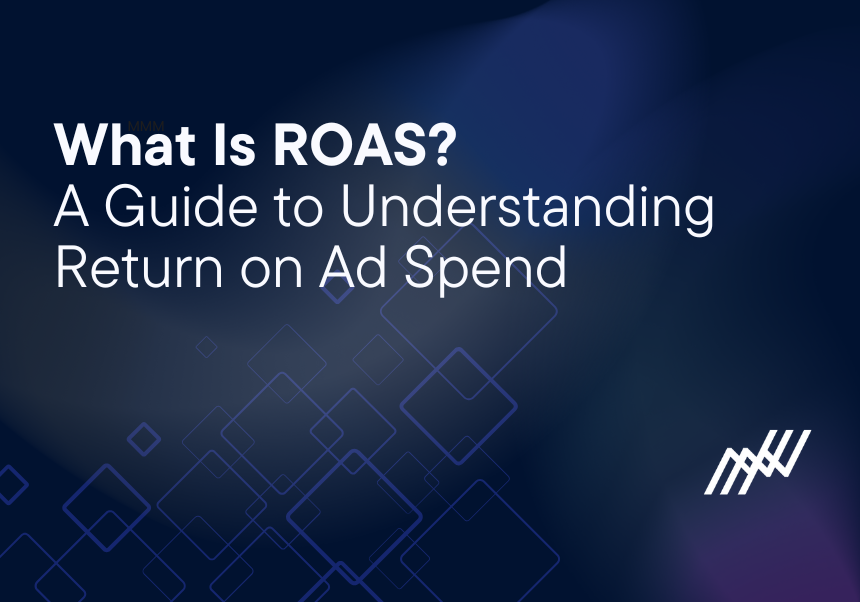
What Is ROAS? A Beginner’s Guide to Return on Ad Spend

Ever felt like you’re throwing money at ads and just hoping something sticks?
Without a clear picture of return on ad spend (ROAS), it’s hard to tell what’s working, and what’s just burning cash.
ROAS, or Return on Ad Spend, is a simple but powerful metric that shows how much revenue you earn for every dollar you spend on advertising.
Whether you're running Meta campaigns or multi-channel growth programs, ROAS helps you evaluate ad efficiency and make smarter budgeting decisions.
In this guide, we’ll break down exactly what ROAS is, how to calculate it, what a “good” ROAS looks like, and how to improve it.
We’ll also explore common mistakes marketers make when tracking ROAS, and how to avoid them.
What is ROAS, and how can you calculate it?
ROAS measures the revenue generated for every dollar spent.
It’s a straightforward metric that helps marketers understand whether their campaigns are profitable and which channels deliver the best results.
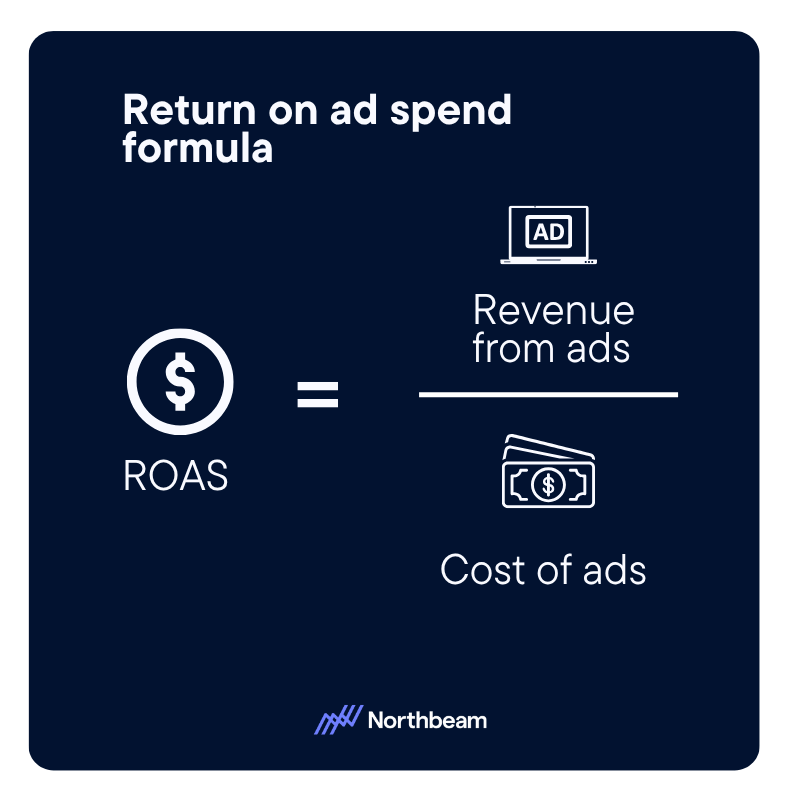
The ROAS formula is calculated simply as Revenue divided by Ad Spend:
ROAS = Revenue / Ad Spend
For example, if your Revenue is $10,000 and your Ad Spend is $2,500, your ROAS would be:
ROAS = $10,000 / $2,500 = 4.0.
In this example, your advertising ROAS is $4 in revenue for every $1 spent.
While calculating the ROAS formula is simple enough, it’s critical to ensure that you’re using the right inputs. Make sure to accurately determine your revenue during a specific period. This could include direct purchases, sign ups, or other types of conversions.
Then, make sure you’re accurately calculating ad spend. Add up all the costs associated with a given campaign, including media buys, creative production, and management fees.
Why does ROAS matter?
ROAS is one of the clearest indicators of whether your marketing dollars are actually delivering results.
Here’s why it matters:
- Profitability check: ROAS shows you whether your ad spend is generating more revenue than it costs. If you’re spending $2,500 and making $10,000, that’s a 4x ROAS — and a strong sign of profitability.
- Budget optimization: By comparing ROAS across different campaigns or channels, you can identify where to allocate more budget for maximum returns.
- Strategic decision-making: A high ROAS indicates profitable campaigns, while a low ROAS signals the need for optimization or a re-evaluation of your strategy.
- ROI proof: Tracking ROAS consistently helps you refine your approach, bring data to the conversation, and improve your overall advertising ROAS.
How and when is ROAS used?
In modern marketing, ROAS is more than a performance metric: it’s a decision-making tool.
Marketers use ROAS to evaluate campaign efficiency, shift spend to high-performing channels, and justify budget increases (or cuts) with real numbers.
Marketers use ROAS for:
- Channel planning: Comparing ROAS across platforms helps teams assess which channels are truly worth the investment. Paid search might drive conversions efficiently, while paid social delivers awareness but lower ROAS.
- In-flight optimization: Running Meta, Google, or TikTok ads? Marketers often monitor ROAS daily or weekly to reallocate spend in real time, turning down underperforming campaigns and doubling down on the winners.
- Post-campaign analysis: After a campaign ends, ROAS is a quick way to assess whether it met revenue expectations — and whether it’s worth repeating.
What is a good ROAS benchmark?
ROAS isn’t one-size-fits-all.
What qualifies as a good ROAS benchmark depends on your industry, business model, channel, margins, and sales cycle.
Here’s how different industries approach good ROAS benchmarks — and why their acceptable ranges vary.
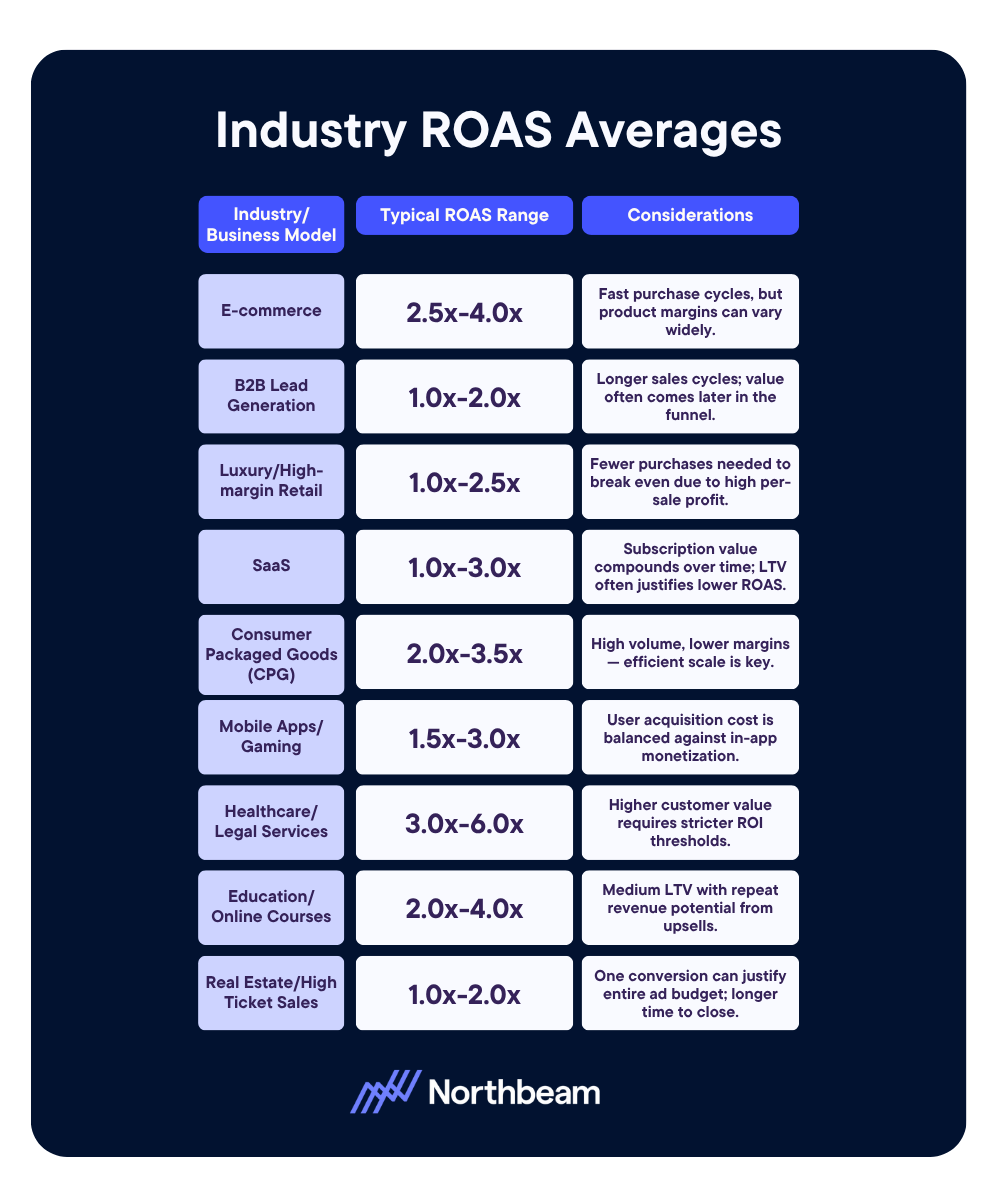
Understanding where your business fits on the ROAS benchmark spectrum helps you set smarter performance targets and avoid apples-to-oranges comparisons.
Whether you’re aiming for a 4x return or making strategic bets on long-term value, ROAS is most powerful when used in context.
How can you best apply ROAS?
Knowing your return on ad spend is only half the battle: the real power comes from using it to guide your ROAS marketing strategy.
Track the Full Picture
To apply ROAS effectively, you need more than just ad spend and top-line revenue. True ROAS depends on accurate tracking of:
- All associated costs: including creative production, agency fees, platform commissions, and even fulfillment if relevant.
- Attribution data: so you know which clicks, impressions, or channels actually contributed to a sale.
Without clean attribution and comprehensive cost tracking, your ROAS may look better (or worse) than it really is, leading to poor decisions.
Automate with the Right Tools
Manual ROAS tracking is time-consuming and prone to error, especially if you’re running campaigns across multiple platforms like Meta, Google, TikTok, and email.
That’s where tools like Northbeam come in. Northbeam automates ROAS calculation using first-party data, cross-channel attribution, and full-funnel insights — helping you see exactly which ads are driving real revenue, not just clicks.
With better visibility, you can:
- Identify your most efficient campaigns
- Pinpoint low-performing spend
- Reinvest confidently for higher returns
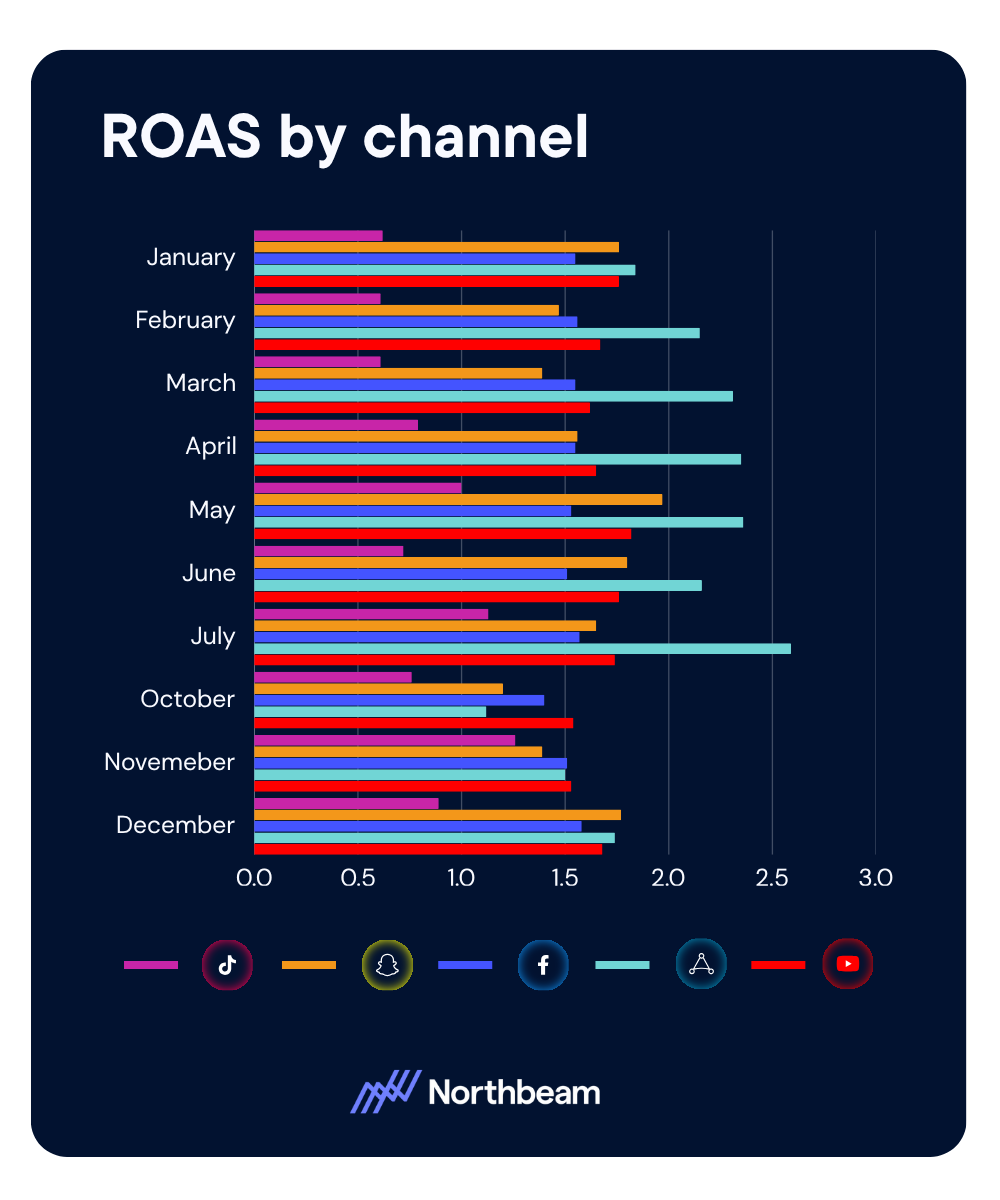
What are some common ROAS mistakes and misconceptions?
ROAS is a powerful metric, but it’s only as accurate as the data behind it — and it doesn’t tell the whole story on its own.
To make smart, high-confidence decisions, avoid these common ROAS pitfalls:
Ignoring multitouch attribution
Many marketers rely on a single-touch attribution model, which gives full credit to the last ad a customer interacted with before converting.
But in reality, most customer journeys are multitouch, spanning multiple platforms and touchpoints.
If you ignore that complexity, you risk undervaluing top-of-funnel campaigns or key supporting channels.
Instead, advanced attribution models — like linear, time decay, or data-driven — offer a more holistic view.
Platforms like Northbeam make it easier to apply these models and accurately track ROAS across the full customer journey.
Over-focusing on ROAS
ROAS can show you whether an ad is generating revenue, but it doesn’t reveal whether those customers will stick around.
A campaign with a high ROAS might bring in low-quality, one-time buyers, while a campaign with lower immediate returns could be acquiring loyal, high-LTV customers.
That’s why it’s important to balance ROAS with other metrics like Customer Lifetime Value (CLV) and Customer Acquisition Cost (CAC) to get a more complete picture of marketing effectiveness.
Overlooking hidden costs
If you’re only factoring in platform spend and ignoring expenses like agency fees, creative production, influencer partnerships, or software tools, your ROAS calculations may be overly optimistic.
To get a true measure of profitability, make sure you’re including all relevant costs in your formula — not just what’s visible in your ad dashboard.
Confusing ROAS vs ROI
While they’re both return metrics, ROAS only measures the revenue generated per advertising dollar spent.
ROI, on the other hand, takes into account all costs, not just ad spend, and calculates net profit.
A campaign can have a high ROAS and still lose money from an ROI perspective once fixed and variable costs are factored in.
A clear, accurate understanding of ROAS, and an understanding of the difference between ROAS vs ROI, is essential for evaluating true business impact and long-term growth potential.
How can you improve ROAS?
Once you’re tracking ROAS accurately, the next step is to improve it.
Whether you're optimizing for efficiency or scaling what already works, here are five proven strategies that can help lift your return on ad spend.
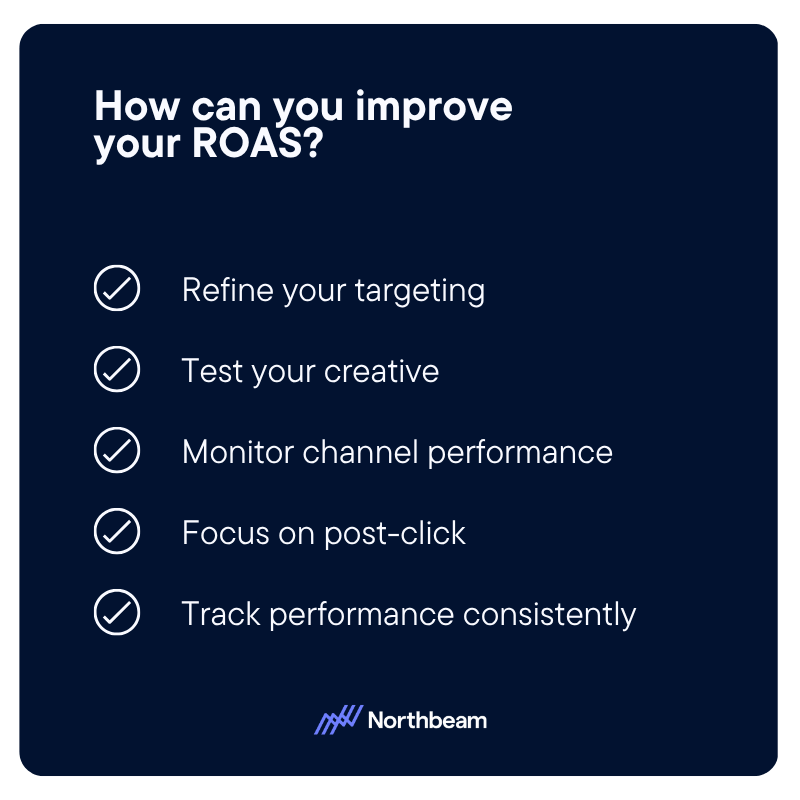
1. Refine your targeting
Use detailed audience segmentation and lookalike modeling to reach people who are more likely to convert, not just click.
Smart targeting ensures your budget is going toward the audiences with the highest potential ROI.
2. Test your creative
A/B testing headlines, visuals, calls to action, and formats across platforms can lead to meaningful gains in conversion rates and ROAS.
Even small improvements in engagement or relevance can have a big impact when scaled.
3. Monitor channel performance
Continuously compare ROAS across channels and campaigns to identify what’s working.
Shift budget toward high-performing channels and pause or restructure underperformers to prevent wasted spend.
4. Focus on post-click
If your landing pages aren’t converting, even the best campaigns won’t deliver advertising ROAS.
Streamline your pages for speed, clarity, and ease of conversion — especially on mobile, where friction can quickly kill ROAS.
5. Track performance consistently
The best way to improve ROAS is to measure it often, and act on the insights.
With platforms like Northbeam, you can monitor ROAS in real time, identify patterns across the funnel, and make data-backed decisions with confidence.
ROAS in Action: MyHD
Learn how MyHD improved their ROAS by +84% with data-driven decision making, enabled by Northbeam.
MyHD DJ Store faced difficulty identifying which marketing channels delivered the best returns, leading to inefficiencies in ad spend.
Northbeam's platform provided MyHD with accurate, actionable insights by consolidating first-party data and offering advanced attribution models.
MyHD achieved an 84% improvement in blended ROAS, a 21% reduction in customer acquisition costs, and optimized marketing efficiency.
Make ROAS work for you
ROAS, or Return on Ad Spend, is one of the most critical metrics for understanding whether your marketing is truly working.
It helps you measure campaign efficiency, optimize budget allocation, and tie revenue back to ad spend.
By calculating ROAS accurately, comparing it to industry benchmarks, and applying smart optimization tactics, you can make more confident, data-driven decisions.
But tracking ROAS manually, especially across multiple channels and touchpoints, can be time-consuming and error-prone.
Explore how Northbeam provides real-time ROAS tracking, cross-channel attribution, and actionable insights that help marketers scale what works, and cut out what doesn’t.

What is AppLovin and How to Leverage it For Marketing Success

If you haven’t heard of AppLovin yet, it’s time to crawl out from under that rock. Long known in the mobile gaming world, AppLovin is now breaking into direct-to-consumer (DTC) advertising — and early adopters are seeing impressive results.
With a massive user base, fresh ad formats, and a self-service platform in beta, AppLovin is quickly becoming one of the most exciting new channels in performance marketing. And it’s not just hype — top brands are reporting Meta-like results at a fraction of the cost.
So what exactly is AppLovin, and why is it working so well for ecommerce brands? Let’s break it down.
A new player in the DTC ad game
AppLovin is a mobile ad network originally built for monetizing mobile games and apps. Its network reaches 1.4 billion users — on par with platforms like TikTok — and has traditionally been used to promote other games. But that’s changing fast.
AppLovin is now opening its doors to ecommerce advertisers, offering a suite of performance-driven tools, ad placements, and a robust algorithm that seems tailor-made for DTC brands.
Why AppLovin works for ecommerce
The psychology is different — in a good way
Mobile gamers aren’t doomscrolling — they’re engaged, focused, and relaxed. When someone beats a high score or clears a level, they’re in a positive emotional state — and that’s when your ad shows up. You’re inserting your brand into a dopamine-rich context, not between two stressful news stories or a chaotic social feed.
This makes a huge difference. Ads feel less like interruptions and more like surprises. That novelty drives higher engagement — and better performance.
The reach is broad
Americans now play more mobile games than they watch cable TV. Over 200 million adults in the U.S. play mobile games weekly, and AppLovin’s network gives you access to all of them. That’s a massive opportunity for building frequency and brand awareness outside the saturated social ad ecosystem.
The ad formats are fresh, but familiar
AppLovin’s ad placements support vertical video and static creatives, and because the context is so different from social, you can often re-use top-performing Meta or TikTok assets without major changes. That’s rare in emerging channels — and it means lower creative lift and faster testing.
The tech is built for performance marketers
From the algorithm to the onboarding process, AppLovin feels like it was built for DTC. Their team has already put together an ecommerce wiki, and their roadmap is aggressively focused on delivering what performance marketers actually need: scale, efficiency, and data transparency.
How to add AppLovin to your marketing mix
AppLovin isn’t a replacement for your core channels — but it’s a powerful complement that can help you reach new audiences and diversify your acquisition strategy.
Here's how to get started:
Start With What You’ve Got
Repurpose your best vertical video or static creatives from Meta, TikTok, or YouTube Shorts. Lean into hook-driven content and test simple iterations to find what resonates.
Track Everything
AppLovin opens up a brand-new slice of time in the customer journey — users playing games. When you track AppLovin touchpoints through Northbeam, you’ll get a complete view of how these ads contribute to conversions across platforms. Whether someone sees your ad in a game and converts via branded search three days later, or after getting hit with a Meta retargeting ad, Northbeam helps you connect the dots.
Think Frequency + Novelty
Your goal isn’t just conversion — it’s attention. AppLovin gives you a way to layer on impressions in a high-engagement setting, helping your brand break through in a fragmented landscape.
The Bull Case for AppLovin
Performance marketers are always chasing the next edge — and, as of April 2025, AppLovin may be it. It combines:
- High reach
- Fresh context
- Low creative lift
- Affordable CPMs
- Early-mover advantage
And when paired with a measurement platform like Northbeam, it becomes even more powerful. You get full visibility into how AppLovin is contributing to your performance across the funnel — so you can scale with confidence, not guesswork.

Grüns’ Power Play: How Northbeam Became the Daily Fix for a Fast-Growing Brand

Grüns’ superfood gummies promise to streamline health into a bite-sized, fruit-snack experience. But the real magic isn’t just in the product—it’s in how they get it in front of the right people. That’s where Northbeam comes in.
We sat down with Claire Yi, VP of Growth at Grüns, to break down how a health & wellness brand in its infancy has already become one of the most exciting DTC players in the space, thanks to a potent mix of aggressive channel testing, a creative-first marketing ethos, and a data backbone that gives them clarity amid the noise.
Northbeam gave Grüns enough integrity and confidence in their data to 22x their spend, which resulted in 40x total revenue. Here’s how they did it.
A Platform Worth Waking Up To
The decision to integrate Northbeam wasn’t a lengthy deliberation for Grüns.
“Our CEO, Chad, was already plugged into a network of DTC founders who swore by Northbeam,” Yi explains. “So, we were early adopters by default.”
The result? Northbeam quickly became the company’s gospel. “I check in every day,” Yi says. “Our CFO checks in. Our CEO checks in. It’s the first look of the day for all of us.”
Moving at the Speed of Growth
Startups live and die by speed, and Grüns is no exception. With the brand not even two years old, Yi’s team needs to pivot on a dime.
“We’re constantly testing new channels,” Yi says. “I rely on Northbeam very heavily every single day. The most useful part of it is just specific metrics like percent new visits by channel, new customer acquisition costs and others. Having that really helps me know if a new channel that we test into is actually bringing in incremental new users to our site.”
That word—incremental—is a big one at Grüns. It’s not enough to get a new customer; they have to be truly new. And that’s where Northbeam shines.
The Obsession With nCAC
If there’s one number that runs the show at Grüns, it’s new customer acquisition cost (nCAC).
“Our entire model is built around it,” Yi says. “We look at nCAC across all our channels—Meta, YouTube, and more —and it helps us benchmark against our holistic goal.”
Northbeam’s ability to separate actual first-time customers from returning buyers or cross-sales means that Grüns isn’t throwing money at inflated metrics. “We don’t trust platform data alone,” Yi adds. Relying on platform data is like letting a chef be the food critic for their own restaurant. It’s almost like being able to have an “Ads Manager” view of all platforms in one view, but without each channel overattributing their conversions across all your orders.
Grüns saw the cost incurred to acquire net new customers decrease by over 14% after implementing Northbeam
Creative is King—And Northbeam is the Court
Grüns isn’t just a performance brand; it’s a creative-driven performance brand. With a heavy emphasis on visuals and storytelling, they need to know immediately which ads are working and which ones need to be optimized.
“We don’t just optimize at the campaign level—we optimize at the creative level,” Yi explains. “Which ad, which visual, which CTA is truly working? Northbeam tells us. We don’t even look at platform data for this anymore.”
And with that kind of granular view into what is truly working, Northbeam becomes a tool to validate all the others. “I use Shopify with Northbeam because it helps us look at day-of performance very sharply, especially during holiday periods or sale periods” Yi says. “We want to be able to scale back if the day is looking a little off from a conversion rate standpoint.”
This ability to instantly separate high-performing creative campaigns from flops means that Grüns can pour budget into winners before a campaign fizzles, maximizing returns with ruthless efficiency.
Expanding the Channel Playbook
In an ever-evolving digital landscape, staying agile is non-negotiable. Grün leverages Northbeam to explore emerging platforms with precision and confidence.
"We've seen exciting new customer growth opportunities by expanding into platforms we had not previously tried," Yi notes. "The ability to quickly test and optimize creatives for new audiences has made a huge impact."
Northbeam’s data-driven insights ensure that every new channel test is informed, measured, and refined—giving Grün the confidence to invest wisely and grow strategically.
More Than Just Numbers—Confidence in the Boardroom
At the end of the day, Northbeam isn’t just a marketing tool—it’s a confidence booster.
“I've been able to use those metrics–nCAC, percent new visits, and more–to explain to stakeholders that a specific channel isn't a priority channel for us right now.” Yi explains. “It also saves us a lot of time in being able to understand at a high level, revenue, new orders, returning orders, marketing spend, and if we're pacing towards our nCAC goals. And it also helps me pull reports really easily to know how much we spent on each channel by month.”
When Grüns needs to decide whether a platform, ad, or creative direction is worth the investment, the answer is already waiting for them. And that’s the real power of Northbeam.
Grüns is building a health & wellness empire with the speed of a tech startup. And in a world where decision fatigue is real and ad dollars vanish into the void faster than you can say "platform algorithm update," Northbeam is their secret weapon for staying sharp, strategic, and relentlessly efficient.

Follow us















.svg)
